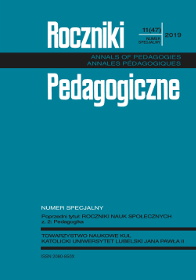The problem of Violetce in family environment as the Skurce of the threat of te human existence
Main Article Content
Abstract
The issue of domestic violence is undoubtedly commonly known. The fast growing mass media pay little attention to it. Stereotypes concerning this phenomenon are still seen in the 21st century and it is them that make the families hide their problem. Outsiders prefer not to get engaged in helping the victims as it is wrongly believed that the issue is a private matter. A vast majority of people assume that aggression, violence and brutal behaviour occurs only in pathological homes, where help cannot be provided due to the way those families function, behaviour is believed to be continued from generation to generation and aggressive behaviour is inherited. There are cases where people from the outside criticise victims claiming it is them who lead to this situation, accepting the issue and not trying to free themselves from the tyrant. Domestic violence may concern any family of any social status. Perpetrators, as well as the victims, may be intelligent, well educated people working on prestigious positions. This phenomenon may undoubtedly touch anyone in society. It is important to fight the existing stereotypes but is not an easy task as the society is often unaware that domestic violence is a collective issue. Changing the common beliefs and increasing social consciousness may be particularly helpful to young people who in a dozen or so years will be the adults creating their countries future. Examples set at home play a basic but vital role in functioning of young generations. The symptoms of aggression not only spoil family and social relationships but also cause a great threat to mental health and the physical human unit. They can irreversibly change a person, as well as disturb all existing existence.
Article Details
References
Bielawska-Batorowicz, E., Hanks, H. (1993). O formach złego traktowania dziecka. Przegląd Psychologiczny, 3, 305-315.
Brągiel, J. (1996). Zrozumieć dziecko skrzywdzone. Opole: Wydawnictwo OU.
Chuchra, M., Jęczeń, J. (2012). Przemoc w małżeństwie i w rodzinie. Lublin: Wydawnictwo KUL.
Hołyst, B. (2013). Zagrożenie ładu społecznego. Warszawa: Wydawnictwo Naukowe PWN.
Kmiecik-Baran, K. (2000). Narzędzia do rozpoznawania zagrożeń społecznych w szkole. Młodzież i Przemoc, 4, 71-84.
Mossakowska, B. (1998). Społeczno-medyczne aspekty Zespołu Dziecka Krzywdzonego. Przegląd Pediatryczny, 28(3), 182-185.
Papież, J., Płukis, A. (1998). Przemoc dzieci i młodzieży. Toruń: Wydawnictwo Adam Marszałek.
Pierzchała, K. (2013). Kapelan więzienny w procesie resocjalizacji penitencjarnej. Toruń: Wydawnictwo Adam Marszałek.
Pierzchała, K. (2015). The Process of Social Reintegration of Convicts on the Background of World Penitentiary System. The Analytical and Synthetic Outline of the Issue. [Proces readaptacji społecznej skazanych na tle światowego systemu penitencjarnego. Zarys analityczno-syntetyczny zagadnienia]. Polskie Towarzystwo Nauk Politycznych i Polska Akademia Nauk. Polish Political Science. Yearbook, 44, 154-170.
Pierzchała, K. (2016). Destygmatyzacja przestępców w świetle Magisterium Kościoła oraz poglądów na resocjalizację. Kraków: Oficyna Wydawnicza „Impuls”.
Pierzchała, K. (2017). Pedagogical and Theological Reflections on the De-Stigmatization Process [Refleksje pedagogiczno-teologiczne nad procesem destygmatyzacji]. Polish Journal of Social Rehabilitation (Resocjalizacja Polska), 13, 17-37.
Pierzchała, K. (2018). Forms of Rehabilitation’s Effects Toward Dysfunctional Family [Formy oddziaływania resocjalizującego wobec dysfunkcjonalnej rodziny]. W: M. Przybysz-Zaremba, W. Ziarek (red.), FAMILY. Tasks – Help – Support. Selected Aspects (s. 249-263). Academic Editing. Lithuania: Mykolas Romeris University in Vilnius.
Pierzchała, K., Cekiera, Cz. (2008). Zwalczanie patologii społecznych w systemie penitencjarnym Polski i USA. Toruń: Wydawnictwo Adam Marszałek.
Pierzchała, K., Cekiera, Cz. (2009). Człowiek a patologie społeczne. Toruń: Wydawnictwo Adam Marszałek.
Pospiszyl, I. (1994). Przemoc domowa. Warszawa: WSiP.
Smarzyński, H. (1978). Rodzina współczesna jako środowisko wychowawcze. Kraków–Wrocław: PAN.
Sołtasiak, T., Nowakowska, A. (red.) (2010). Młode pokolenie ofiary czy sprawcy przemocy? Bydgoszcz: Wydawnictwo Uniwersytetu Kazimierza Wielkiego.
Szczukiewicz, P. (red.) (2007). Przemoc domowa – wybrane zagadnienia. Lublin: Wydawnictwo MAD.
Szymczaka, M. (red.) (1988). Słownik języka polskiego (t. 2). Warszawa: PWN.

